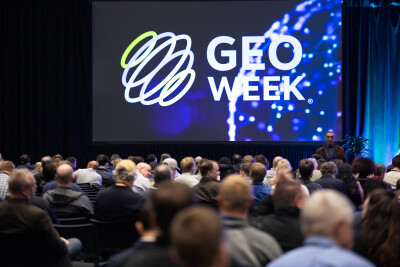Open to the public since 1806, Grand Caverns has been a tourist attraction for over two centuries. The show cave boasts geographic beauty, extensive nature trails in the surrounding area and forms part of Virginia’s rich history. 3D mapping the site became another chapter in the cavern’s future after a professor and undergraduate students from James Madison University geospatially scanned the oldest show cave in the United States, Grand Caverns in Virginia, digitally mapping the largest room in 3D for the very first time.
Data collection
Using GeoSLAM’s handheld ZEB Horizon scanner, Geology and Environmental Science assistant professor Angel A. Garcia Jr. from James Madison University (JMU) in Harrisonburg, Virginia, has led a team of students in creating a digital map of the historic cave rooms. With a collection rate of 300,000 points per second, an accuracy of up to 6mm and the ability to scan data with a range capacity of 100m, the ZEB Horizon captured a detailed 3D point cloud of the entire system of caves in just over 12-minutes. The data collection size is 667MB, collected using the ZEB Horizon alone.
The parts of the cavern that were scanned, reached over 4,000 m/2 and were over 350 meters in length. One room with two small chambers was completed in one single scan. Since this initial phase, Angel and his team of students have gone on to scan an estimated 95% of the whole cave, including an additional eight small rooms. Three students were involved in this scanning process. The scan was conducted as part of Angel’s academic research, with geology students taking segments of the findings to develop their own academic studies.

Scanning without GPS signals
The ZEB Horizon’s ‘walk and scan’ method of data collection offers fully-mobile technology. Powered by SLAM (Simultaneous Localization and Mapping) technology, the device does not require GPS signals, enabling Professor Garcia Jr. and his team of students to carry out the scan below ground level. The scan data is captured in the Scanners Own Coordinate System (SOCS) and can be georeferenced to a global coordinate system in post-processing. GeoSLAM is able to geo-reference using on-trajectory control points and matching these to known anchor points within the scanned environment. To do this, the user holds the scanner over a single point for around 10 seconds, this then creates a reference point which can later be compared to known geographical points in the scanned environment.
Data processing and measuring
Once collected, the 3D point cloud was processed in GeoSLAM Hub, and measured using GeoSLAM Draw. GeoSLAM HUB was one of the first desktop-based software applications that was released to process the LiDAR data from GeoSLAM’s mobile mapping scanners. HUB is able to process data from any scanner type, as well as performing other functions such as colorizing from video data (ZEB Cam), merging and reprocessing data.
GeoSLAM Connect is the latest version of GeoSLAM’s processing software and is designed to create fully-automated workflows so that data can be cleaned, geo-referenced and decimated. This is the easiest way to process data from ZEB scanners, and performs an improved version of the SLAM algorithm, resulting in fast and accurate point clouds.
GeoSLAM Draw is an optional software that complements the processing of point cloud data, allowing the user to further evaluate the processed data. It uses an orthophoto of scan data that can be loaded directly from Hub or Connect, enabling the user to work with the whole point cloud without interference from, and detriment to, performance issues from a computer – as loading in full point clouds can be difficult to work with.
Hub was GeoSLAM’s primary processing platform until September 2021 when Connect was launched. Using Hub, users can transform their 3D data into actionable information in minutes, combining industry-leading SLAM technology with powerful post-processing. The new Connect software is powered by GeoSLAM’s next generation SLAM algorithm, and includes 3D visualization of data, additional processing and filtering, workflow automation tools, and integration into third party software applications. GeoSLAM Draw is an additional add-on software to Connect, which includes tools to quickly extract sections from point cloud data.
Data use
The collected data is being used to measure speleothem formations, monitor human impact, create 3D printed models and provide an insight into the geo-heritage of the cave. Geo-heritage is a framework in which multiple heritages coexist, especially in a geological feature or scenario. Grand Caverns is the oldest continually-operating show cave in the continental US, with operations starting back in 1806. Constructing a LiDAR point cloud (or 3D map) promotes the geological heritage in the cave by granting opportunities of academic and student research, and the means of ‘cave-referencing’ other heritages that are visible in the cave.







